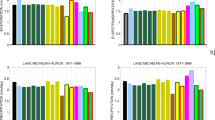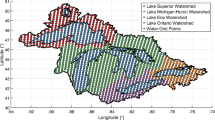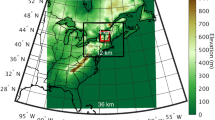Abstract
A new method is proposed to estimate future net basin supplies and lake levels for the Laurentian Great Lakes based on GCM projections of global climate change. The method first dynamically downscales the GCM simulation with a regional climate model, and then bias—corrects the simulated net basin supply in order to be used directly in a river—routing/lake level scheme. This technique addresses two weaknesses in the traditional approach, whereby observed sequences of climate variables are perturbed with fixed ratios or differences derived directly from GCMs in order to run evaporation and runoff models. Specifically, (1) land surface—atmosphere feedback processes are represented, and (2) changes in variability can be analyzed with the new approach.
The method is demonstrated with a single, high resolution simulation, where small changes in future mean lake levels for all the upper Great Lakes are found, and an increase in seasonal range—especially for Lake Superior—is indicated. Analysis of a small ensemble of eight lower resolution regional climate model simulations supports these findings. In addition, a direct comparison with the traditional approach based on the same GCM projections used as the driving simulations in this ensemble shows that the new method indicates smaller declines in level for all the upper Great Lakes than has been reported previously based on the traditional method, though median differences are only a few centimetres in each case.




Similar content being viewed by others
References
Angel JR, Kunkel KE (2010) The response of Great Lakes water levels to future climate scenarios with an emphasis on Lake Michigan – Huron. J Great Lakes Res 36:51–58
Caya D, Laprise R (1999) A semi-implicit, semi-Lagrangian regional climate model: the Canadian RCM. Mon Weather Rev 127:341–362
Chao P (1999) Great Lakes water resources: climate change impact analysis with transient GCM scenarios. J Amer Wat Res Assoc 35(6):1499–1507
Clites AH, Lee DE (1998) MIDLAKES: A Coordinated Hydrologic Response Model for the Middle Great Lakes. NOAA Technical Memorandum ERL GLERL-109. Great Lakes Environmental Research Laboratory, Ann Arbor, p 48
Cohen SJ (1986) Impacts of CO2—induced climatic change on water resources in the Great Lakes basin. Clim Change 8:135–153
Croley TE II (1983a) Great Lakes basin (U.S.A.-Canada) runoff modeling. J Hydrology 64:135–158
Croley TE II (1983b) Lake Ontario basin (U.S.A.-Canada) runoff modeling. J Hydrology 66:101–121
Croley TE II (1989) Verifiable evaporation modeling on the Laurentian Great Lakes. Wat Resour Res 25(5):781–792
Croley TE II (1990) Laurentian Great Lakes double—CO2 climate change hydrological impacts. Clim Change 17:27–47
Croley TE II (2003) Great Lakes climate change hydrologic impact assessment. I.J.C. Lake Ontario—St. Lawrence River Regulation Study. NOAA Technical Memorandum GLERL – 126
Hagedorn R, Doblas-Reyes FJ, Palmer TN (2005) The rationale behind the success of multi—model ensembles in seasonal forecasting—I. Basic concept. Tellus 57A:219–233
Hartmann HC (1990) Climate change impacts on Laurentian Great Lakes levels. Clim Change 17:49–67
Houghton JT, Meira Filho LG, Callander BA, Harris N, Kattenberg A, Maskell K (Eds) (1996) Climate Change 1995: the science of climate change. Contribution of WGI to the second assessment report of the Intergovernmental Panel on Climate Change. Cambridge University Press, Cambridge, UK and New York, NY, USA, pp. 584
International Upper Great Lakes Study (2009) Impacts on upper Great Lakes water levels: St. Clair River. Final report to the International Joint Commission, December 2009
Jungclaus JH, Keenlyside N, Botzet M, Haak H, Luo J-J, Latif M, Marotzke J, Mikolajewicz U, Roeckner E (2006) Ocean circulation and tropical variability in the AOGCM ECHAM5/MPI-OM. J Clim 19:3952–3972
Kristovich DAR et al (2000) The lake induced convection experiment and the snowband dynamics project. Bull Amer Met Soc 81:519–542
Lettenmaier DP, Gan TY (1990) Hydrologic sensitivities of the Sacramento—San Joaquin River basin, California, to global warming. Wat Resour Res 26(1):69–86
Leung LR, Qian Y, Bian X, Washington WM, Han J, Roads JO (2004) Mid-century ensemble regional climate change scenarios for the western United States. Clim Change 62:75–113
Lofgren BM, Quinn FH, Clites AH, Assel RA, Eberhardt AJ, Luukkonen CL (2002) Evaluation of potential impacts on Great Lakes water resources based on climate scenarios of two GCMs. J Great Lakes Res 28(4):537–554
Lofgren BM, Hunter TS, Wilbarger J (2011) Effects of using air temperature as a proxy for potential evapotranspiration in climate change scenarios of Great Lakes basin hydrology. J Great Lakes Res 37:744–752
MacKay M, Bartlett P, Chan E, Verseghy D, Soulis ED, Seglenieks FR (2008) The MAGS regional climate modeling system: CRCM-MAGS. IN Cold Region Atmospheric and Hydrologic Studies, the Mackenzie GEWEX Experience, Vol 1: Atmospheric Dynamics, 433–450, Ming-ko Woo ed., Springer, pp. 470
Marchand D, Sanderson M, Howe D, Alpaugh C (1988) Climatic change and Great Lakes levels: the impact on shipping. Clim Change 12:107–133
Mortsch LD, Quinn FH (1996) Climate change scenarios for Great Lakes basin ecosystem studies. Limnol Oceanogr 41(5):903–911
Mortsch LD, Ingram J, Hebb A, Doka S (eds) (2006) Great Lakes coastal wetlands communities: vulnerabilities to climate change and response to adaptation strategies. Final report submitted to the Climate Change Impacts and Adaptation Programme, Natural Resources Canada
Quinn FH (1978) Hydrologic response model of the North American Great Lakes. J Hydrology 37:295–307
Salas-Melia D, Chauvin F, Deque M, Douville H, Gueremy J-F, Planton S, Royer J-F, Tyteca S (2005) Description and validation of the CNRM-CM3 global coupled model. CNRM Tech Rep 103
Scinocca JF, McFarlane NA, Lazare M, Li J, Plummer D (2008) The CCCma third generation AGCM and its extension into the middle atmosphere. Atmos Chem Phys Discuss 8:7883–7930
Scott RW, Huff FA (1996) Impacts of the Great Lakes on regional climate conditions. J Great Lakes Res 22:845–863
Solomon S, Qin D, Manning M, Chen Z, Marquis M, Averyt KB, Tignor M, Miller HL (eds.) (2007) Climate Change 2007: The Physical Science Basis. Contribution of Working Group I to the Fourth Assessment Report of the Intergovernmental Panel on Climate Change. Cambridge University Press, Cambridge, UK and New York, NY, USA,pp. 996
Tebaldi C, Knutti R (2007) The use of the multi—model ensemble in probabilistic climate projections. Phil Trans R Soc A 365:2053–2075
U.S. Environmental Protection Agency (1989) The potential effects of global climate change on the United States. Report to Congress. Smith JB and Tirpak DA (Eds) Report EPA-230-05-89-050, EPA Office of Policy, Planning, and Evaluation, Washington D.C
Wilcock D, Wilcock F (1995) Modelling the hydrological impacts of channelization on streamflow characteristics in a Northern Ireland Catchment in Modelling and Management of Sustainable Basin-scale Water Resource Systems (Proceedings of a Boulder Symposium, July 1995). IAHS Publ. no. 231
Wittenberg H (1994) Nonlinear analysis of flow recession curves. Flow Regimes from International Experimental and Network Data (Proceedings of the Braunschweig Conference, October 1993). IAHS Publ. no. 221
Wood AW, Leung LR, Sridhar V, Lettenmaier DP (2004) Hydrological implications of dynamical and statistical approaches to downscaling climate model outputs. Clim Change 62:189–216
Acknowledgments
The CRCM4.2.3 data has been generated and supplied by Ouranos. We would also like to thank the Canadian Center for Climate Modelling and Analysis for providing the CGCM3 archives. Jim Angel is kindly acknowledged for providing the data from Angel and Kunkel 2010. Funding for this research was provided by the International Upper Great Lakes Study.
Author information
Authors and Affiliations
Corresponding author
Rights and permissions
About this article
Cite this article
MacKay, M., Seglenieks, F. On the simulation of Laurentian Great Lakes water levels under projections of global climate change. Climatic Change 117, 55–67 (2013). https://doi.org/10.1007/s10584-012-0560-z
Received:
Accepted:
Published:
Issue Date:
DOI: https://doi.org/10.1007/s10584-012-0560-z




